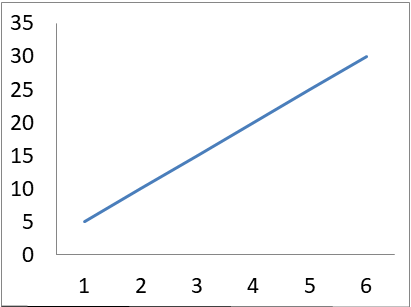
If there is an increase in a series at constant rate, the graph will be a _______.
${\text{A)}}$ Convex curve
${\text{B)}}$ Concave curve
${\text{C)}}$ A straight line from left top to right bottom
${\text{D)}}$ A straight line from left bottom to right top
Answer
558k+ views
Hint: To find the answer without any doubt, we have to assume and consider a series first, and then increase the series at a constant rate i.e., with the same amount or number.
After that, we will represent in a graph and also we will be able to see the cures and lines clearly
Finally we get the required answer.
Complete step-by-step solution:
Let us assume a simple series distribution which is increasing at constant rate:
Here, every number is increasing by $5$ (thus at constant rate)
Now, representing this table in the graph, we get:

As we can see, the change in the graph is a straight line from left bottom to right top.
Hence we can conclude the correct option is (D) A straight line from left bottom to right top.
Note: In this question we have an alternative logical answer as follows:
Basically a series consists of a sequence with some common operations in it and almost in every case, the number will be increasing in certain rate and sometimes it will be in a decreasing rate too.
Considering in that way, when the numbers are increasing at a constant rate, the difference between the points will be the same and the points in the graph will also increase in a constant rate as the difference is the same, thus we will get a straight line from left bottom to right top.
In case, if the series is decreasing at a constant rate, the graph will be a straight line from left top to right bottom.
After that, we will represent in a graph and also we will be able to see the cures and lines clearly
Finally we get the required answer.
Complete step-by-step solution:
Let us assume a simple series distribution which is increasing at constant rate:
| ${\text{x}}$ | $1$ | $2$ | $3$ | $4$ | $5$ | $6$ |
| ${\text{y}}$ | $5$ | $10$ | $15$ | $20$ | $25$ | $30$ |
Here, every number is increasing by $5$ (thus at constant rate)
Now, representing this table in the graph, we get:

As we can see, the change in the graph is a straight line from left bottom to right top.
Hence we can conclude the correct option is (D) A straight line from left bottom to right top.
Note: In this question we have an alternative logical answer as follows:
Basically a series consists of a sequence with some common operations in it and almost in every case, the number will be increasing in certain rate and sometimes it will be in a decreasing rate too.
Considering in that way, when the numbers are increasing at a constant rate, the difference between the points will be the same and the points in the graph will also increase in a constant rate as the difference is the same, thus we will get a straight line from left bottom to right top.
In case, if the series is decreasing at a constant rate, the graph will be a straight line from left top to right bottom.
Recently Updated Pages
Why are manures considered better than fertilizers class 11 biology CBSE

Find the coordinates of the midpoint of the line segment class 11 maths CBSE

Distinguish between static friction limiting friction class 11 physics CBSE

The Chairman of the constituent Assembly was A Jawaharlal class 11 social science CBSE

The first National Commission on Labour NCL submitted class 11 social science CBSE

Number of all subshell of n + l 7 is A 4 B 5 C 6 D class 11 chemistry CBSE

Trending doubts
What is meant by exothermic and endothermic reactions class 11 chemistry CBSE

10 examples of friction in our daily life

One Metric ton is equal to kg A 10000 B 1000 C 100 class 11 physics CBSE

1 Quintal is equal to a 110 kg b 10 kg c 100kg d 1000 class 11 physics CBSE

Difference Between Prokaryotic Cells and Eukaryotic Cells

What are Quantum numbers Explain the quantum number class 11 chemistry CBSE




